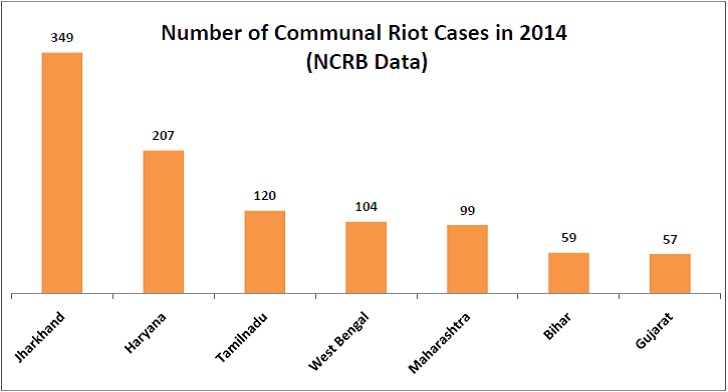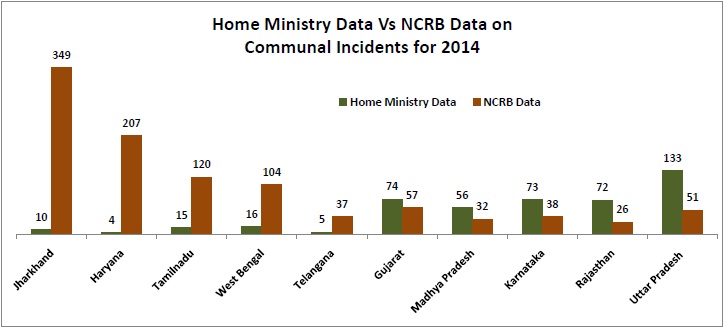[orc]The data on communal incidents by the National Crime Records Bureau seems to have opened a Pandora ’s Box. The NCRB data counts more than 1200 communal incidents in 2014 while the Ministry of Home Affairs counted only 644 such incidents in 2014. There is a difference in data for as many as 23 States/UTs.
There is yet another controversy brewing over the issue of communalism and spread of communal incidents. There are news reports that the Home Ministry has ordered a probe to find out why its data on communal incidents is different from that of NCRB. While the Home Ministry data says there were 644 communal incidents in 2014, the NCRB data puts this number at 1227. Here is the entire issue explained in detail.
NCRB Data Collection on Riots
The National Crime Records Bureau (NCRB) is an attached office in the Ministry of Home Affairs (MHA). NCRB is tasked with collection and dissemination of a secure national database on crimes, criminals and law enforcement agencies etc. Every year, the NCRB collects data from Police departments at the state level and compiles it into a Crime in India report. The report has detailed information on various types of crimes.
In 2014, the NCRB has made significant changes to the method of its collection and dissemination of crime data. In its new template for collection of crime related data, there is a section on riots as defined under Sections 147,148,149,150 & 151 of the Indian Penal Code (IPC).
There is a separate section to collect data on offences that promote enmity between different groups as defined under Sections 153A & 153B of the IPC.
Before 2014, all the data related to riots used to be collected under one head called riots. From 2014, the data on riots is categorized into many different sub heads namely communal riots, Industrial riots and riots for political reasons etc. The data collected under Sections 153A & 153B is counted as Communal riots.
One has to remember that NCRB gets all the data from state police departments. And this data is strictly based on the sections mentioned in the First Information Report (FIR) of the cases filed. The NCRB also follows ‘Principal Offence Rule’ for counting of crime. Hence among many offences registered in a single case, only most heinous crime will be considered as counting unit, thereby representing one case.
What does the NCRB data say about Communal incidents?
The NCRB data on riots has a sub categorization of communal riots. As per the NCRB data, a total of 1227 communal riot incidents took place in the country in 2014. More than 2000 people were victims of these incidents. Leading the list is Jharkhand with 349 incidents followed by Haryana with 207 incidents. Tamil Nadu is third with 120 incidents followed by West Bengal (104), Maharashtra (99), Bihar (59) & Gujarat (57). This data is in direct contradiction with the MHA data. Jharkhand, Haryana, Tamil Nadu & West Bengal do not have significantly high number of incidents as per the MHA data. In fact, the number of incidents in each of those states is less than 20 as per the MHA data. Uttar Pradesh that had the highest number of incidents (133) as per MHA, is 8th in the NCRB list with 51 communal riot cases.
What is interesting is that the number of victims is more or less same in both the data sets. While the MHA data puts the number of victims at 2016, the NCRB data puts it at 2001.
Difference between NCRB & MHA Data
There is a difference in the numbers put out by NCRB & MHA for as many as 23 States/UTs. The data matches only for 13 States/UTs and these are States where both NCRB & MHA reported ‘zero’ incidents. There is a double digit difference in 11 states and the difference is quite stark for the following 10 states. For Jharkhand, the MHA reported only 10 incidents while NCRB reported 349 incidents. At the other end of the spectrum is Uttar Pradesh. While MHA reported 133 incidents, the NCRB reported only 51 incidents. Same is the case with Haryana, Tamil Nadu, West Bengal, Telangana, Gujarat, Madhya Pradesh, Karnataka, Rajasthan & Uttar Pradesh.
What could be the possible reason?
The NCRB numbers could be high only because of the reason that hate speeches qualify as incidents in NCRB data (because of Sec 153A in FIR), while they might not be counted as incidents by the Human Rights Division of the MHA. But even then, the NCRB numbers should be higher in every state and we should not have had a mixed trend. The only plausible reason for such huge discrepancy is the shoddy work of the state police and the intelligence departments. But why would they goof up such data is a million dollar question. This also raises some uncomfortable questions about the sanctity of government data.






